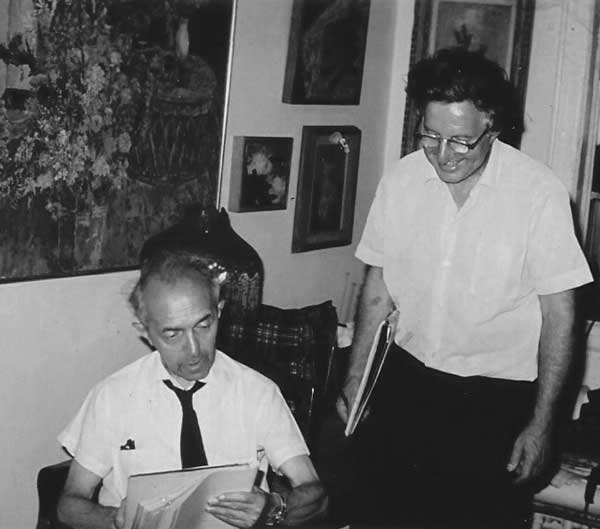critics’ voices
Lawrence Alloway
“The Arthur Dove Exhibition at the Whitney Museum,” The Nation, January 17, 1976.
“One of Herman Rose[’s] roofscapes, . . . steals the show. . . . His patient development, subtle color sense, and acute eye for tonal values deserve to be celebrated by more than the few who know him at present.”
Lawrence Campbell
“Herman Rose at the Fishbach Gallery, West 57th Street,” Art in America, May 1990.
“Herman Rose, . . . is, in my opinion, the greatest living painter of landscape and still life in the U.S. . . . In 1952 when Dorothy Miller selected him for one of the group exhibitions of Americans at the Museum of Modern Art (the others that year included Jackson Pollock, Mark Rothko, Edwin Dickinson, Frederich Kiesler, and Willian Baziotes) the poet Frank O’Hara commented that Rose more than held his own . . . . It is in this artistic company, and as part of the New York School, that Rose surely belongs.”
Emily Genauer
“Gallery Roundup,” Herald Tribune, February 1962.
“Herman Rose. . . . In the gentle, post-pointillist tradition of a Pissarro or a Vuillard, his canvases were intimate revelations of the poetry in a city roofscape, or in the leafy corner of a backyard.”
Grace Glueck
“Herman Rose,” Fishbach Gallery, West 57th Street, The New York Times, November 7, 1983.
“Rose [has] done for the New York rooftop what Hart Crane did for the Brooklyn Bridge. Perceiving with a poet’s eye the bizarre medley of structures that rear in the city . . . Mr. Rose reinvents them. . . . He is [also] a master of still life. . . . Particularly beautiful are those still lifes set off against a backdrop of the city.”
Gerrit Henry
“Herman Rose, Fishbach Gallery, West 57th Street,” Art in America, January 1984.
“Herman Rose holds a position rare in the art world: he’s the painter’s painter’s painter . . . he’s something of the grand old man of painterly realism. . . . What separates Rose’s work from Woolworth art? Vision of course, and technique – but also something that can only be called a divine spark.“
Hilton Kramer
“Herman Rose’s New York,” The New York Times, May 21, 1967.
“At his best he is . . . a remarkable artist who has somehow preserved the integrity of his sensibility – essentially private, jealous of its own dreams and sensitivities – through a period when the most persuasive artistic currents were all running the other way. . . . Mr. Rose exists as a kind of survivor of the esthetic wars, and he has survived with honor and vigor.”
Hilton Kramer
“Herman Rose” Deutsch Gallery, West 57th Street, December 4, 1981.
“The watercolors in this exhibition are marvelous, and must surely be counted among the most beautiful works anyone has produced in this challenging medium for many years.”
Stuart Preston
“About Art and Artists,” The New York Times, September 16, 1954.
“A fine harbor view by Herman Rose which announces again that he is the Boudin of our days.”
Theodor F. Wolff
“The Many Masks of Modern Art,” Christian Science Monitor, March 3, 1981.
“It wasn’t until the mid-1960s that . . . . lyrical, self-contained realistic art, . . . began to be taken seriously again. . . . Most of these works were modest, as was the case with those by Giorgio Morandi, . . . and those by Herman Rose. The latter’s small and often exquisite studies of street scenes and studio interiors can only be described as painterly gems.”
Theodor F. Wolff
“Giant Steps Forward by the National Academy,” Christian Science Monitor, March 29, 1983.
”Herman Rose . . . submitted ‘Manhattan Morning,’ and with it garnered one of the academy’s top prizes. It also wins my vote as the best painting in the show.”

Herman Rose with Raphael Soyerc. 1950s